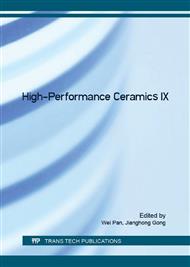p.386
p.390
p.395
p.399
p.404
p.409
p.414
p.419
p.423
Preparation and Performance of Neutron Absorbing Dysprosium Oxide Ceramic
Abstract:
Dysprosium is a kind of potential neutron absorption material with the thermal neutron absorption cross area of 950 Barn. In this paper, dysprosium oxide (Dy2O3) ceramic was prepared by pressureless sintering. The density, bending strength, fracture toughness and hardness of Dy2O3 ceramics under different sintering schedule were analyzed. The density of Dy2O3 ceramics was enhanced accompanied with the increase in sintering temperature, and it was close to the theoretical value when heated at 1630 °C. Bending strength reached a maximum of 117 MPa when sintering temperature was 1570 °C. However, fracture toughness was inversely proportional to the hardness approximately. As a consequence, the optimum sintering temperature for mechanical property of Dy2O3 ceramics was 1570 °C. The morphology of fracture surface was examined by SEM. The results showed that the porosity of Dy2O3 ceramics decreased with increasing temperature. Meanwhile, the Monte-Carlo software was used to simulate the neutron absorption property. The absorbtivity was about 99.13% when the neutron source was uniform energy spectrum of 10-11 Mev~10-5 Mev and the thickness of Dy2O3 was of 20 mm.
Info:
Periodical:
Pages:
404-408
Citation:
Online since:
July 2016
Authors:
Keywords:
Price:
Сopyright:
© 2016 Trans Tech Publications Ltd. All Rights Reserved
Share:
Citation:


